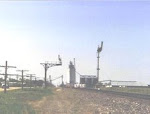I seem to be the only one I know that gets any of this.
Put yourself back in 1955. You are driving along a long straight piece of highway through a pastoral country setting. On your left are cultivated crops growing military-like in their neat rows, alternating with pasture or ground left fallow. On occasion a barn and farmhouse zoom by. On your right is open prairie with more agriculture in the distance, but pacing the highway is a railroad track. It is a main line and you know that because of the poles and wires following tightly along the right of way. They carry electrical impulses not only of communication but of signal indication as well.
Punctuating the track are those line side signals, silver-painted masts with a ladder for maintenance and the black-faced heads. In the center of the head is a hooded light which displays the condition of the track ahead--occupied or clear.
The signals and poles zip by. If only a train would pass to enliven the drive. In those old days you might have longed to see one of the road's passenger fleet. Immaculate stainless-steel sided cars stretching into the distance, let by a streamlined first-generation diesel locomotive. They would glide by almost noiselessly, faster than you could legally go on the highway, with passengers resting in air-conditioned comfort. Which incidentally, few of us had in automobiles. The named trains all carried a lighted sign at the end of the last car proudly proclaiming its identity.
Or maybe a distant haze on the horizon would convert into a pinhole-sized light which seemed to stand still. As you drove toward it the light would begin to be defined by a the blackness of a working steam locomotive, large and menacing, with almost a mile of freight cars in tow. The cars would be from everywhere carrying almost everything. Look-alike unit trains of coal or double-stack container freight were still in the future in the mid-50's.
Sometimes you might catch a meet: two trains passing each other in opposite directions, most often with one waiting on a siding while the other holds the mainline. Sometimes you could catch a glimpse of the signal changing colors as an unseen train approached. If the railroad had semaphore signals, you might get the rare opportunity to see one change positions as you and a train both passed by one.
Trains could sure put life in a trip. Midwestern scenery is fine and watching license plates used to help break up a long trek. Burma-Shave signs were an exciting find. But there was little to compare with the ever-changing life along the rails. Work crews were always out with exotic-looking machines. Sometimes your gas stop was adjacent to a small town's wooden frame depot, complete with a high-wheeled baggage cart on the brick platform and a mail-bag post next to the tracks. And a water tower for the steam engines. Or perhaps as you crossed a major river you would see a magnificent railway bridge, black from soot, dwarfing the trains that used it.
Airplanes get you there faster but they just don't have character like trains did back then. Now, following a rail line is much more sanitized. Steam is gone forever. The communication and signal lines are disappearing leaving mainlines looking bare. Signals are strategically placed to maximize their effectiveness. Passenger trains are a rarity and freights are often land-bridges of impersonal coal and foreign-owned containers.
But you know what? I'd still rather follow the rails. Like I say, I'm the only one that gets it.
Subscribe to:
Post Comments (Atom)








No comments:
Post a Comment